How strange to think we’re almost half a century into our fourth industrial revolution or the digital revolution as we call it. The first was way back in 1765 with the development of mechanization. A century later, new energy sources like electricity, gas, and oil drove a massive technological advance. In 1969 nuclear energy arrived on the scene, quickly followed by the Internet in 1983.
Today, the digital revolution rolls on and has become a constant transformation we regard as a norm. We’ve grown to expect to change daily. So how do we choose our communication platform and tools for a workplace that was changing rapidly even before the massive impacts of the COVID-19 global shutdowns?
What is internal communications?
Internal communications are designed to inform, engage, and motivate workers to perform to the best of their abilities and effectively deliver the company’s strategy. The best internal communication programs distribute consistent, clear, and timely information to drive collaboration and productivity across the workplace. This includes remote, offshore, and hybrid work locations. And doing this requires an assist from several internal communications tools.
What are internal communication tools exactly?
Internal communication tools are the software or platforms enabling a company to manage its employee communications. These tools streamline communications, reducing the requirement for face-to-face interactions and thereby increasing efficiency and productivity. But one can’t merely have tools without a plan!
The importance of an internal communications plan
- Good communications mean a more positive work environment where employees understand expectations, responsibilities, and boundaries.
- Employees experience increased motivation when goals are clearly identified in clear communications.
- Where communication channels are open, workers can be innovative and creative, share ideas, quickly make decisions, and solve problems.
- Information distributed to employees when and where they need it helps them complete their everyday work the best way possible.
- Management skills are strengthened through a good communication strategy that helps delegate tasks, motivate workers, resolve conflicts, and build relationships.
- Compliance with company policy can be easily maintained and adjusted where necessary for employees to understand workplace expectations and to feel safe and welcome.
- Communication is vital for collaboration so that company goals and vision can be shared and complex processes presented to teams in achievable steps.
- A recognized brand image can be maintained by a consistent communication style and tone, encouraging loyalty and sales.
Find out how to create a brilliant internal communications plan here.
Internal communication tools no business should be without
During the 1980s and 1990s, traditional internal communication tools gave way to electronic and hybrid ones. For example, company newsletters might be designed on a computer, then printed to be distributed on paper. Spreadsheets were the same. Data was entered and manipulated electronically, then printed out as physical reports.
The first two decades of the twenty-first century saw a new, more dramatic shift — from electronic and hybrid systems to fully digital, cloud-based solutions. The following list lays out the digital teamwork and historical internal communication tools and platforms that have changed the face of business communications.
1. The Intranet
Business intranets started out as clunky, hard-to-use systems that were custom-built for enterprise companies. They weren’t modeled on consumer-facing apps because, in the 1980s, there wasn’t any such thing. Not yet. For many companies, those legacy systems became sunk costs in terms of money, people-hours, and data. It wasn’t easy to move away from a bespoke, one-of-a-kind system.
Today’s modern, user-friendly intranets integrate with popular collaboration tools and solutions — including databases and communication tools — so implementing them is fast and easy. They are the best platform choice for all your internal communications. The intranet shares information and knowledge between large and small groups, whether on-site, remote, or globally dispersed. Another great benefit is that a modern intranet like Simpplr requires no IT maintenance and is intuitive for employees to use—no training needed. This intranet can be deployed fast, in days rather than months.
They’re also built on many of the same design principles that have defined the success of consumer-facing social media apps, making them extremely easy for employees to use. In addition, Simpplr’s out-of-the-box prescriptive analytics allow you to see which content drives the most interest and discover new content promotion methods that will increase user retention and encourage further engagement.
Unite internal stakeholders and make the business case for a modern intranet with this eight-step guide to choosing the right intranet solution.
A mobile intranet app is also highly recommended because not everyone is a desk sitter. Keep employees in the loop wherever they are so they can receive communications exactly when and where they need them.
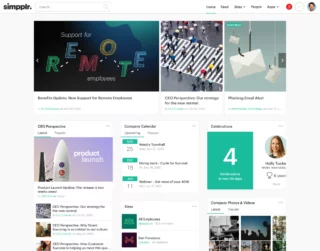
2. Project management
Digital, cloud-based systems have revolutionized project management, and it’s now pretty much unthinkable that we somehow managed to do all this on paper in the past. Today, project managers and even individual team members have internal communications tools to flag new issues and mark what’s done. They can also coordinate their remote work with efficient, effective communication using real-time project management tools.
Centralized, collaborative task management makes it easy for employees to see what they’re responsible for and when, both within and across departments, even when priority levels must change on the fly. Some popular tools to try are Jira, Asana, and Trello.
Popular project management tools:
- Jira
- Asana
- Trello
3. Calendar coordination and management
Gone are the days when a meeting could only be rescheduled through numerous emails and phone calls. Calendaring tools have changed everything, making it easy to manage and change dates and times, even for multiple team members scattered across time zones.
Cloud-based calendars solved that problem but introduced a new one, making it so easy to set up meetings that individual work time started to erode. In 2022, more than half of US professionals reported spending 30% of their work week in meetings.
Easy as they are to set up nowadays, meetings and discussions need to balance with the rest of the workload. Today’s cloud-based calendars allow users to set share permissions both individually and as groups. This way, they can block off individual time to work while still finding time for scheduled meetings.
Popular calendaring tools:
- Google Calendar
- Microsoft Outlook
4. Instant messaging
While full meetings have always been important to team collaboration in the workplace, but what if remote team members need the answer to just one quick question? Distributed teams and remote work have changed business methods, and thanks to instant messaging, anyone, anywhere, can now ask that quick question. This is one of today’s crucial internal communication tools, allowing individual conversations and easy group chats to keep the team organized and moving forward.
Modern communication software can even extend that convenience through mobile apps for Android and iOS. Just remember that mobile device notifications can also lead to burnout. Make sure your team knows how to set notification permissions to define a good work-life balance.
Popular instant messaging tools:
- Slack
- Microsoft Teams
Tip: With Simpplr, you can integrate with Slack and MS Teams and share company news from your modern intranet, so your employees never miss an important announcement no matter where they are.
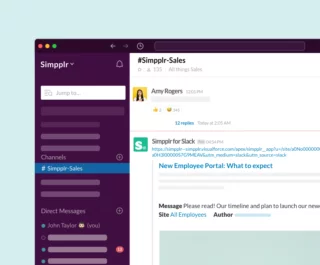
5. Video conferences & webinars
For remote teams, video conferencing is a vital internal communication tool. Video calls give people the important face-to-face communication that brings and holds teams together. Video meetings and webinars are widely used today to build better relationships with suppliers, vendors, and offices in different cities or around the world.
When you add screen sharing and video chat tools for real-time collaboration, video conferencing is an efficient, effective way to share work and discuss possibilities. Popular video conferencing tools to consider are Zoom, Microsoft Teams, and Google Meet.
Popular video conferencing tools:
- Zoom
- Skype
- Hangouts from Google
6. Video sharing
According to new research from MIT, the human brain can process images 60,000 times faster than text. That’s just one of the many reasons why video is such an effective way to drive employee engagement.
Companies share videos of employee success stories, social media stories, training for new systems, and much, much more.
When looking for an intranet solution to tie your team communication tools together, look for one with native video capability.
Popular video-sharing services:
- YouTube
- Vimeo

7. Document collaboration
Document collaboration tools help your team share and work on documents together, even at the same time. More than just a matter of convenience, these internal communications tools also minimize the mistakes that used to happen when multiple versions of a document were floating around the office.
A cloud-based document suite with modern collaboration features is an essential tool in almost every business.
Popular document collaboration tools:
- Google Workspace (formerly G Suite)
- Microsoft Office 365
8. File sharing
Like document collaboration, file sharing lets you share documents with other team members, but file sharing is more limited. Where document collaboration lets multiple people actively work on the same document, file sharing simply lets people download files from a central location.
File sharing is excellent for approved logos and photos, pdf reports, or product shots that can be reused across different website pages or ad campaigns.
Placing these key items in a central location also removes the chance of accidentally losing important documents when an employee leaves the company, and their email is deleted.
Popular file-sharing tools:
- Google Drive
- Dropbox
- OneDrive
Tip: Have a look at Simpplr Search, which is federated, meaning in addition to searching content from the entire intranet, it also searches any integrations plugged into Simpplr, such as file repositories like Dropbox, Google Drive, or SharePoint. This allows your team members to find content from one centralized location. Useful file-sharing tools worth considering include Google Drive, Dropbox, and OneDrive
8. File sharing
Like document collaboration, file sharing lets you share documents with other team members, but file sharing is more limited. Where document collaboration lets multiple people actively work on the same document, file sharing simply lets people download files from a central location.
File sharing is excellent for approved logos and photos, pdf reports, or product shots that can be reused across different website pages or ad campaigns.
Placing these key items in a central location also removes the chance of accidentally losing important documents when an employee leaves the company, and their email is deleted.
Popular file-sharing tools:
- Google Drive
- Dropbox
- OneDrive
Tip: Simpplr Search is federated, meaning in addition to searching content from the entire intranet, it also searches any integrations plugged into Simpplr, such as file repositories like Dropbox, Google Drive, or SharePoint. This allows your team members to find content from one centralized location.

9. Knowledge centers and wikis
Knowledge centers and wikis do for team knowledge what file sharing does for files, putting that information in a central location where anyone can access it.
These are great internal communications tools because companies use them to document policies and procedures, share data and other reports, manage customer communication schedules such as emails or newsletters, and more.
Permissions can be set on a space-by-space or even a page-by-page basis. A small team, for example, might share the ability to change their internal procedures, while spaces for customer-support scripts can be protected against accidental changes.
Searchable wikis keep everyone on the same page while saving valuable time, allowing employees to look up what they need to know.
Popular wiki tools:
- Atlassian
- Trello
Tip: Simpplr not only integrates with popular wiki tools like Atlassian but also allows teams to create centralized knowledge centers within the Simpplr platform itself. Some popular knowledge centers can include sites such as all things related to HR, New Hire Onboarding, and even closed groups where users can access information only if given access.
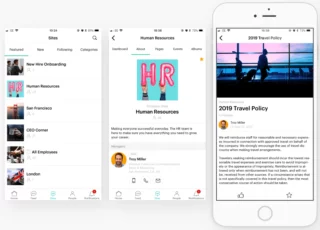
10. Employee directories
Employee directories can range from simple lists of names and contact information to complex, dedicated HR databases that capture and store employee information, potentially including sensitive personal data.
While a basic list of names and phone numbers could easily be part of a small business wiki, keeping up with employee information across a global operation is a different ballgame. Ensure your employee directory solution matches the complexity and security of your specific needs.
Popular employee database tools:
- Oracle
- SAP
- ADP
- Workday
Note: Simpplr integrates with your employee database tool and provides an easily searchable directory and organizational chart within the intranet. Employees can quickly and easily connect with the right people, and employee profiles help them get to know each other, further driving engagement.
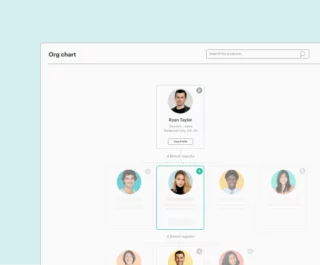
11. Internal blogs and news
There are many ways to manage an internal company blog or news feed. Recent news can go on a centralized wiki page, but busy people are unlikely to see it very often, if at all. Regular emailed newsletters aren’t particularly personalized and can be overlooked.
When employees see too much news that has nothing to do with their job or division, they’ll be unlikely to open that email. A great alternative is a company newsletter integrated into a modern intranet with adaptive personalization. Each employee can see a newsfeed that’s unique to them, enhancing employee experience and driving engagement.
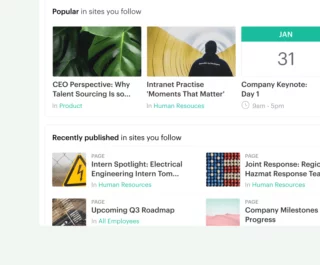
12. Data and analytics
Today’s companies manage tremendous data — sales numbers, website traffic, customer support response times, employee engagement, and more. The data would be overwhelming without modern analytics tools to interpret it.
Still, making sense of that data and getting it in front of the people who need it are two completely different tasks.
When modern intranet software includes data analytics, it combines the power of big data with smart business communications, turning insights into action.
Simpplr, for example, offers built-in analytics at every level, from global usage down to individual pages, feeds, profiles, and more, offering HR teams the ability to turn up the volume on employee engagement.
Popular analytics tools:
- Google Analytics
- Zendesk
- Salesforce
13. Discussion boards and forums
Internal discussion boards and forums make the best internal communications tools because they can host multiple asynchronous conversations across different functions and geographic locations. Organized by topic, they facilitate the exchange of ideas between employees who might otherwise never meet.
From the C-suite to customer service to the warehouse workers, taking full advantage of your company’s shared intellectual capital has never been so easy.
Connected forums within your intranet provide employees with one convenient source for all their work communications and updates.
14. Employee surveys
Email isn’t a terrible way to communicate, but offices discovered early on that it’s a lousy way to work. Messages get buried, attachments get lost in long email chains, and finding what you need can be a big waste of time.
Today’s email integrations offload task-related messaging into centralized locations like calendars and project management software. Similarly, integrations in the other direction let users choose how they want to receive those calendar and project notifications, even if it’s in an old-school email.
15. Onboarding center
A new job always has its own stress points, even for the most experienced worker. An onboarding center offers a series of helpful steps for new recruits to be more quickly informed, engaged, and able to contribute to their team, and integrate from day one.
16. Email integrations
Email still has a role to play, but not in every theater. Most of us know by now that messages get buried, and attachments get lost in long email chains, and trying to find what you need in all that can be a big waste of time. Today’s email integrations offload task-related messaging into centralized locations like calendars and project management software. Similarly, integrations in the other direction let users choose how they want to receive those calendar and project notifications, even if it’s in an old-school email.
17. Social media communication
With social media’s introduction, researchers have been wondering how much communication is too much, and for a good reason. New research from Yale suggests that unmoderated social media is making us morally outraged.
It’s no wonder many employers shy away from what could be a valuable tool for marketing and hiring outreach
To strike the right balance, modern companies manage employee engagement on social media by providing pre-made posts with clear guidelines. That way, an engaged workforce can chime in without creating PR headaches.
Final thoughts
All of the internal communications tools and technologies listed above can improve employee engagement, building a strong business case for a bespoke internal communications strategy. To support the case to prove the ROI of a strong internal communications strategy to the C-suite and other leadership, reach out for a demo and read the free e-book 5 Steps to Internal Communications ROI.















